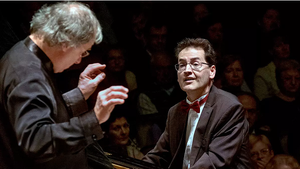Review from the director of Bela Bartok Centre for Musicianship in London

© Gábor Fejér
The second concert of the Bartók Spring 2023 festival presented two relatively little-known Bartók pieces. Both compositions are from Bartók’s youth but clearly deserve the attention which they now had.
Originally written for solo piano in 1904, Bartók had high hopes for his Op.1 Rhapsody for Piano and Orchestra which initially did not bring success. In 1905 Bartók entered the Rubinstein competition in Paris as pianist and composer, but the recognition only stretched to a diploma for Bartók, with no first and second prize awarded. However, at the Budapest premiere in 1909, with Jenő Hubay conducting, the reviews were complimentary, and the audience was very enthusiastic.
Following the structure of the nineteenth-century slow-fast rhapsody form, this c.17-minute-long Rhapsody includes numerous gypsy-type augmented second intervals (both in the solo piano and the orchestra), followed by humour and excitement aided by heavy orchestral instrumentation with all wind, brass and percussion instruments which can be accommodated in a symphony orchestra. As pianist, Bartók kept the piece on his repertoire for many years, thus arguably indicating his satisfaction with it. It seems a shame that – apart from a few recordings – the Rhapsody seems to have almost disappeared from our awareness in the twenty-first century.
Composed in 1904-5 and originally titled as Burlesque, Bartók’s Scherzo for Piano and Orchestra was virtually unknown for over half a century. Bartók was dissatisfied with an ill-prepared orchestra for the planned premiere, withdrew performance rights and preferred to forget about the composition. The score remained unpublished until Belgian Bartók scholar Denis Dille found it in Bartók’s estate in 1961. Dille declared the work as very important, partly because of its technical mastery. Distinguished Bartók scholar Professor László Somfai agrees with Dille’s suggestion regarding Richard Strauss and Liszt influences on the composition but also cites several later Bartók works which have their seeds in the Scherzo. The orchestral forces are exceptionally large and include unusual variations. For instance, Bartók uses an Ab clarinet (as well as Eb and Bb clarinets).
Pianist Dénes Várjon, conductor András Keller and the whole orchestra delivered high quality performances despite obvious technical challenges (as well as possibly some discomfort on the crowded stage). Várjon is new to both pieces, at least – according to an interview – this was the first time that he played them at a concert … a premiere Várjon can be proud of. Bartók’s humour is evident in both compositions and Várjon superbly conveyed this aspect. His stamina is also commendable: Bartók did not spare the soloist (nor the orchestra). On conclusion of the long and taxing Scherzo, there is an unexpected duet for the pianist and a solo violinist: both Várjon and the concertmaster delivered beautifully. At the end of the Rhapsody, there is a lovely horn solo: again, wonderfully played by presumably the first horn.
After the two very taxing orchestral piano pieces Várjon presented Bartók the folklorist: as an encore, he played the Three Folksongs from the Couny Csik. You could have heard a pin drop in the concert hall, such was Várjon’s loving engagement with these pieces and the audience’s appreciation for them.
After the interval, following the two Bartók piano-orchestra works and the solo piano encores, we were treated to Bach’s Third Brandenburg Concerto which ten string players and a harpsichord player presented without a conductor. No problem with the performance – the orchestra has excellent players – but the waiting time before and after might have been taxing for the audience. I for one found the clearing the stage and then refurbishing the stage at that stage of the evening a bit of a distraction. It is not clear (to me) why the programme included a Bach chamber piece between the large orchestral works, although I love the piece.
Conductor András Keller presented fire in the first movement of the Beethoven’s Seventh Symphony; lovely speed, and appropriately subdued dynamics in the second movement (with excellent contribution from the wind section). The third movement felt slightly rushed to this pair of ears but, nevertheless, with a majestic slow section which included some magical pianissimos. The last movement was again full of fire and high speed; Keller sent home the audience with top quality energy … after a top-quality concert.
